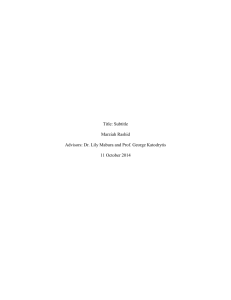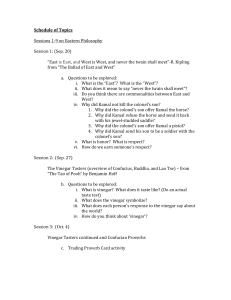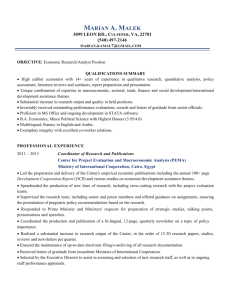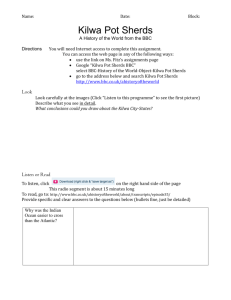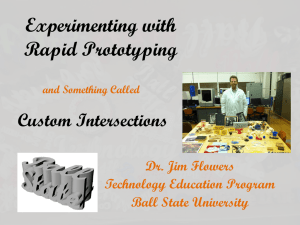Pivato, Joseph_Magic Of Saida-VassanjiB
advertisement
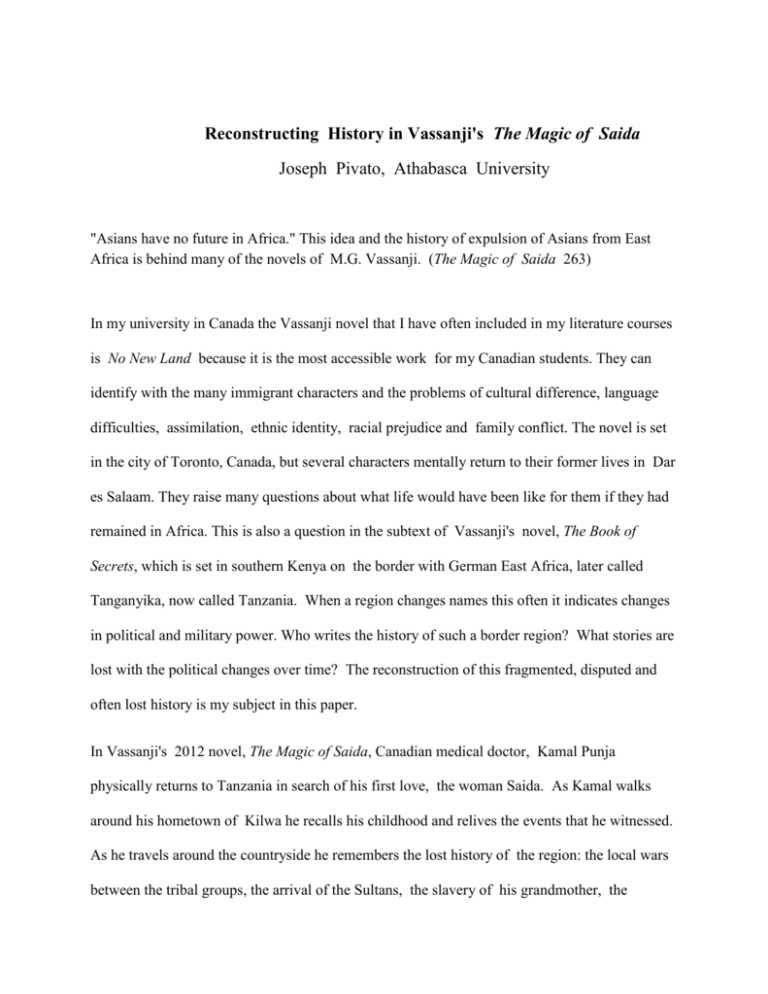
Reconstructing History in Vassanji's The Magic of Saida Joseph Pivato, Athabasca University "Asians have no future in Africa." This idea and the history of expulsion of Asians from East Africa is behind many of the novels of M.G. Vassanji. (The Magic of Saida 263) In my university in Canada the Vassanji novel that I have often included in my literature courses is No New Land because it is the most accessible work for my Canadian students. They can identify with the many immigrant characters and the problems of cultural difference, language difficulties, assimilation, ethnic identity, racial prejudice and family conflict. The novel is set in the city of Toronto, Canada, but several characters mentally return to their former lives in Dar es Salaam. They raise many questions about what life would have been like for them if they had remained in Africa. This is also a question in the subtext of Vassanji's novel, The Book of Secrets, which is set in southern Kenya on the border with German East Africa, later called Tanganyika, now called Tanzania. When a region changes names this often it indicates changes in political and military power. Who writes the history of such a border region? What stories are lost with the political changes over time? The reconstruction of this fragmented, disputed and often lost history is my subject in this paper. In Vassanji's 2012 novel, The Magic of Saida, Canadian medical doctor, Kamal Punja physically returns to Tanzania in search of his first love, the woman Saida. As Kamal walks around his hometown of Kilwa he recalls his childhood and relives the events that he witnessed. As he travels around the countryside he remembers the lost history of the region: the local wars between the tribal groups, the arrival of the Sultans, the slavery of his grandmother, the European wars fought by colonial rivals, the displacements of thousands of people in East Africa and his own departure for Canada. Reconstructing History The term 'reconstructing history' is usually found in anthropology, the study of human evolution and behavior. Anthropologists will sometimes reconstruct a specimen and the narrative from fragments, bones and other objects found at a dig site. I am applying the idea of this practice to Kamal's search in Tanzania and his reconstruction of a narrative about his family, and his own life. As a result of this reconstruction Kamal, his narrator and Vassanji are rewriting the history of the region against the other histories of the former colonial powers in Africa. As we read the chapters in this novel we find that Kamal's life is intertwined with the lost history of East Africa. Vassanji is not only writing Kamal's story but also recreating the history of colonial intervention by Germany and Great Britain. We are reminded of this turbulent history in every chapter of the novel: Chapter one begins with these words, Kilwa was all history, Kamal said. The past haunted from the ruins and graves; it was there in the references to the Germans who had ruled there once, and the slaves who were sold there, he heard it in his mother's tales and he heard it recited - majestically - by the old poet, Saida's grandfather. (9) This old poet, Mzee Omari Tamin, is an important figure throughout the novel and the history of Kilwa and the whole region. The novel begins with Mzee Omari writing his major work, The Composition of the Coming of the Modern Age, which is in fact his history of colonialism in the region from the point of view of the local Africans. In chapter 13, Mzee Omari recites short excerpts of his history to the people of Kilwa. The young Kamal is one of the attentive listeners sitting in the dark and trying to understand the German colonial wars against the different local tribes: the Sadani, the Pagani, the Swahili, and the fierce Hehe. The young Kamal is troubled by the question, “Why would Africans fight fellow Africans on behalf of the Germans ?” (81) We often get the point of view of the young, naive Kamal as he asks questions of the adults around him, questions which are often left unanswered. Narrative Framing Kamal is telling his story to Martin Kigoma, an African he met while in hospital. Martin is in fact the narrator of the novel. The story of Kamal’s return to East Africa after 35 years in Canada is the narrative frame for the history of the region as lived and told by the old poet Mzee Omari. Kamal has returned in search of Saida, the old poets granddaughter, and has great difficulty finding her. In his search he also finds that there is little material evidence left of Mzee Omari’s writing. So in recalling the events in his early life in Kilwa, his memories of Saida, Kamal also tries to reconstruct the life and writing of Mzee Omari. The narrative framing of history is clear in Part Two of the novel, entitled, "of the coming of the modern age." (121) Here Kamal reconstructs the history of his Indian great grandfather, Punja Devraj, and his migration from India to Zanzibar and then Kilwa. When the Germans annex East Africa, many tribes resist and are put down. There is a rebel group in Kilwa that the Germans capture and Punja Devraj and four Africans are hanged in Kilwa. These people are hanged from the large mango tree in the central square of Kilwa, the same mango tree that Mzee Omari uses to hang himself in the 1960s. We can interpret the reappearance of this mango tree as a sign that Kamal's reconstruction of the history of his family is a frame and a substitute for the missing and unfinished history by the old poet, Mzee Omari. Problems With Writing History In the middle of the narrative Kamal recognizes the many problems he has in trying to reconstruct this history: That so much of our history lies scattered in fragments in the most diverse places and forms--fading memories, brief asides or incidentals in a book and in archives--is lamentable, but at least they exist. All we need do is call up the fragments, reconfigure the past. (131) Kamals search for Saida is connected to his uncovering the fragments of his family's past and the history of Kilwa. Every chapter has a clue to these missing people, and their stories. In Chapter 3 we read, There were actually three Kilwas: the Island, called Kisiwani, the ancient stone city now in ruins; Kamal’s Kilwa, which saw its heyday in the nineteenth century trade in ivory and slaves; and Masoko, the markets…scattered about the main road to the harbour. (16) In Chapter 4 we learn that Kamal has been haunted all his life by the history of slavery in his mother’s family. “All those years while he practiced [medicine] in Edmonton, Kamal had collected a small library on the subject of Kilwa….” (29) Kamal’s plan is to write a family history so that “ his children would know where they came from, who their ancestors were.”(29) In Chapter 5 we read more about the history of Kilwa, the rich Sultan of Kilwa with the castle on the island, the German colony, and later under British rule Tanganyika’s struggle for selfgovernment. Changing Identities Intertwined with this lost and disputed history, a history with many versions, is Kamal's own changing identity. At the end of Chapter 7 the young Kamal learns about his grandmother’s slavery and that Kilwa was the center of East African slave trade long before the arrival of Europeans. (50) The young Kamal grows up in Kilwa identifying as a Black African since his mother is African. But he is slowly made aware that he is different. His father is a medical doctor from India and has left his mother in Kilwa while he has returned to India. Nevertheless his father’s family consider Kamal is an Indian and later claim him in order to raise him as an Indian and send him to school. So when Kamal is 13 his mother sends him to Dar es Salaam to his uncle, Jaffu Ali Punja and his Indian family. Kamal eventually becomes Indian, A Mhindi. Kamal also becomes a very good student and because of his high marks is admitted to university to study medicine. With a local Indian student, a young woman named Shamim, he travles to Makerere University in Kampala, Uganda. After Kamal completes two years of medical school in Uganda, General Idi Amin leads a military coup and later expels Asians from Uganda. Kamal and his girlfriend Shamim decide to go to Canada. This migration is encouraged by his uncle Jaffu and his whole family. So Kamal spends the rest of his life in Canada. He thinks he identifies as Canadian, but upon his return to Kilwa, Tanzania he becomes confused about who he is, and what he is. He explains his dilemma to a local doctor in Kilwa, Well. I am here and these are my people, and yet I have a life and a family elsewhere. In Canada I've thought of myself as African--though not African Canadian or African American--attractive illusions for a while. It becomes difficult to say precisely what one is anymore. Isn't that a common condition nowadays? (222) Speaking For A Scattered People In my years of reading authors who explore cultural diversity in Canada I have often found that they try to recreate the lost history of their people from the fragments of texts, stories of dislocation, exile, and migration. Many of these writers of diversity work in the conventions of the realist tradition as they try to find the truth about the social movements and historical events of their people. They are sometimes criticised for being so concerned with the social history of a period or of a place. These writers are often trying the put together some lost story from hearsay or old letters. They become a voice for an exiled people who have been uprooted and scattered to different parts of the world. The Asians expelled from East Africa are such a people. Vassanji in writing about them gives them a voice. Remember that 'diaspora' is a term we have taken from the history of the Jews scattered during and after in the Roman empire. Whenever I make these observations about a writer speaking for an ethnic minority group I get into trouble with the scholars and students of post-colonial theory. The appropriation of voice controversy will always emerge in these discussions. But I continue to read and interpret the original work before the theory. My study of Italian-Canadian writers has taught me to listen to their voices unmediated by abstract European theories. (Pivato, 1994) In a 2013 interview in the Canadian newspaper, The Globe and Mail, Vassanji explained what he sees as his role in writing the history of his people: There are people who feel their histories, their stories - they would like them to be told. And when you do that in your writing, they feel that you have done something for them, and that puts a burden on you. (Globe & Mail R5) History and Lies In The Magic of Saida there are varying versions of every story. The young, naive Kamal is easily persuaded by the words of the old poet, Mzee Omari. He is Saida's grandfather and a much admired man in Kilwa. But as he grows older Kamal begins to question the stories. He realizes that no body, not even his mother, gives him all the information when he asks questions. It is when Mzee Omari hangs himself on the same mango tree that the Germans used to execute the rebels in Kilwa, that Kamal realizes that Omari may have been implicated in the suppression of the rebellion. (107, 177). Omari in composing and reciting his great work on the history of colonialism in Tanzania is trying to rewrite the versions published by the European powers. But Omari cannot overcome the guilt of his part in the German capture of the rebels (145), and later the death of his older brother, Abdelkarim (163). Omari's other great sin is that he often stole his death brother's poetry and passed if off as his own to build up his reputation as an original writer in the region. Kamal recalls when, as a boy, he last spoke to Omari and read some of his verses about the suppression of the rebellion. (103) Soon after this meeting Omari stopped writing; is as if he could not face the truth about himself. With his death Omari leaves his great work of history unfinished. From his study in Edmonton and during his travels Kamal spends 35 years researching this lost history of Kilwa. Upon his return to Tanzania he begins to piece together this history. The novel is not just Kamal's search for Saida, but also his reconstruction of this fragmented history. He finds that there is nothing left of Omari's poems or other writing, not even a shred of paper. "None of them survive except as subjects of hearsay, or in memorized fragments. A few corrupted verses...." (176) As Kamal proceeds to piece together the events in Kilwa he finds that it is difficult to learn the truth. There are only different versions of the narrative. What is the history of Kilwa? In his own search for Saida he finds that the people around him have deceived him for years. Before he when off to university in Kampala Kamal had gone back to Kilwa to see Saida, the girl he loved, and had promised her he would return to her. Many years later he learns that while he was in university in Kampala, the young Saida had gone to see his uncle in Dar es Salaam with their baby son. He was never told this. Instead he was urged to go to Canada with his girlfriend, Shamim. This part of the story ends tragically. Does Kamal ever find Saida ? Witnesses To History In his 1994 novel, The Book of Secrets, Vassanji uses the lost and found journal of Assistant District Commissioner, Alfred Corbin. This document from 1913 serves as a witness to the events in this vulnerable border region between Kenya and German East Africa. In The Magic of Saida we find many scenes and references that link it to The Book of Secrets. In the earlier book we also find different versions of historical event such as the rebellion against the German colonizers and the African battles during World War I. In The Magic of Saida Kamal himself is the main witness to the history of the region. He recalls events, identifies people, now dead, and searches for physical evidence of the past in order to write his story and find Saida. Throughout the novel Kamal, with the scientifically trained mind of a medical doctor, tries to make a logical narrative out of the chaos of the colonial wars, the confusion of different and conflicting narratives and fragments from the past. For the most part he succeeds in bringing order. He dismisses superstitions and folk remedies and advises people to go to the hospital when they have health problems. But Kamal himself is not immune from the diseases of Africa. The book open with him seriously ill in hospital with malaria. In his delirium his mind begins to play tricks on him. Is it his mind or is it Africa that is play with his perceptions. He returns to the naive point of view of the child he was in Kilwa 50 years in the past. The novel ends with Kamal in a dream or hallucination. In his search for Saida in the jungle hamlet of Minazi Minne he is overwhelmed by the power of Africa. Is his experience a druginduced hallucination, or does he speak to Saida in a dream ? His scientifically trained mind is of little help in this scene. We question Kamal's dangerous actions at the end of the novel. The Return Journey In my years of studying authors of cultural diversity I have found that the problem of the return journey is an important preoccupation for some writers. Many are driven to return to the country or region of origin for many different reasons: family ties, nostalgia, politics, or spiritual need. What is less common is the conscious or unconscious return journey for the purpose of dying in the old country. Kamal demonstrates this death wish on some unconscious level. He repeatedly puts himself in danger in his travels around Tanzania. At some level he is tortured by guilt at having abandoned Saida many years earlier. In the final scene of hallucination or dream Kamal seems to accept that he may die. Like the old poet Mzee Omari so many years ago in Kilwa, Kamal is willing to accept his death as a reparation or punishment for his own betrayal of Saida. Here Kamal is not just reconstructing history, but trying to repeat history. The Nostalgia Question The Magic of Saida is a very evocative novel, a story of loss. Kamal returns to Tanzania primarily to seek out his lost love, Saida, but is there also some nostalgia for his idyllic childhood in Kilwa? I would argue that he is motivated by guilt over his abandonment of Saida, more than any nostalgia. Kamal recalls how he was abandoned by his African mother and later learns that he was lied to by his Indian uncle and his whole family. Kamal willingly left Africa as a young man and abandoned Saida. But he also abandoned East Africa, a region in great need of his skills as a doctor on medicine. At some level his return quest for Saida is a way of trying to come to terms with his obsession, his betrayal and guilt. But Africa too is a place which can betray your love and punish you for it; his mother disappears out of his life, his uncle Jaffu deceives him and Saida tries to punish Kamal at the end of the novel. He really cannot go home again. As Kamal tries to reconstruct the history of his home region, a story of loss, he realizes that he has a love-hate relationship with Africa. The author's own love-hate relationship with Africa is explored in some of the articles collected in M.G. Vassanj: Essays on His Works edited by Asma Sayed. I have found that a comparative literature approach is the best way to read Vassanji's novels and it is often useful to draw parallels with other African works, other South Asian works and other Canadian works which deal with cultural differences. Canadian writing itself has had a troubled relationship with the colonial condition of a former British colony. (Pivato, 2011) I will end with some words by Vassanji himself from the 2013 interview in the Globe and Mail in which he explains some of his motivation in writing history, For me, I come from a culture where there's no writing about ourselves as such. There are a lot of oral tales, and so for the first time to write something about people who've not been written about at an intimate level, there's a big hurdle. I overcame it, for some reason, I found the guts to do it. But living here [in Canada] I thought, 'They'll never read it anyway!' Works Cited Bland, Jared. "The Write Stuff." (interview) The Globe and Mail (Toronto) Sat. Oct. 5, 2013. p. R5 Pivato, Joseph. "The Return Journey in Italian-Canadian Literature," Canadian Literature 106 (1985), 169-176. _____. "Oral Roots of Italian-Canadian Writing." Echo: Essays on Other Literatures. J. Pivato. Toronto: Guernica Editions, 1994, 77-100. _____."The Sherbrooke School of Comparative Canadian Literature." Inquire: Journal of Comparative Literature 1.1 (2011) online http://inquire.streetmag.org/article/25 Sayed, Asma. ed. M.G. Vassanj: Essays on His Works. Toronto: Guernica Editions, 2013. Vassanji, M.G. No New Land. Toronto: McClelland & Stewart, 1990. _____. Book of Secrets. Toronto: McClelland & Stewart, 1994. _____. The Magic of Saida. Toronto: Doubleday Canada, 2012. Note: A version of this paper was presented at the conference: The Transnational Imaginaries of M.G. Vassanj, at the School of Oriental and African Studies, University of London, U.K. on November 8-10, 2013.
